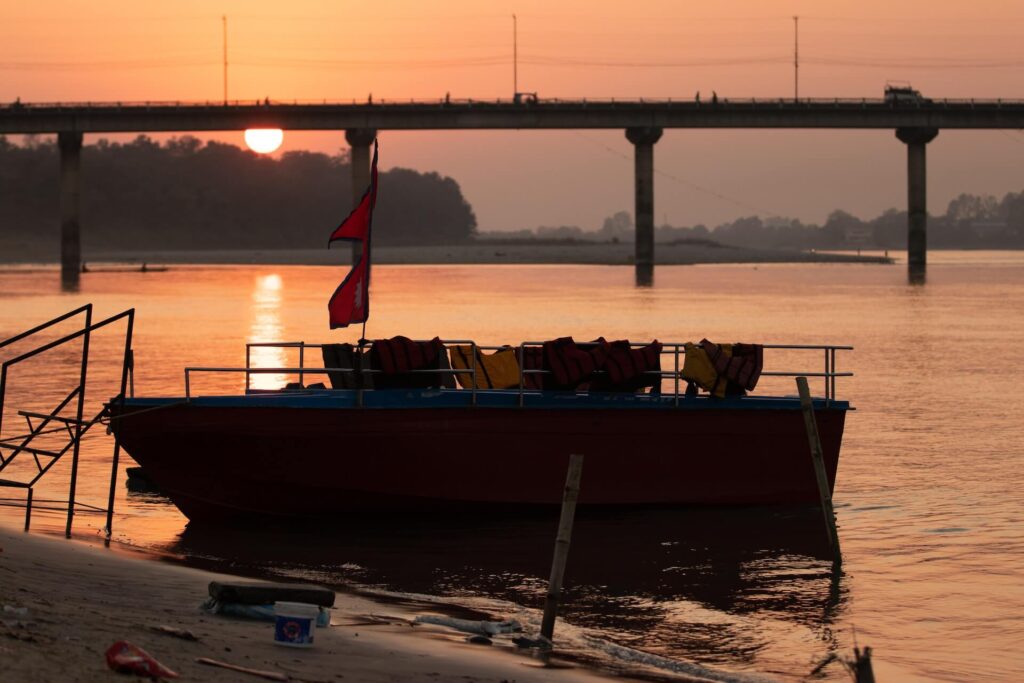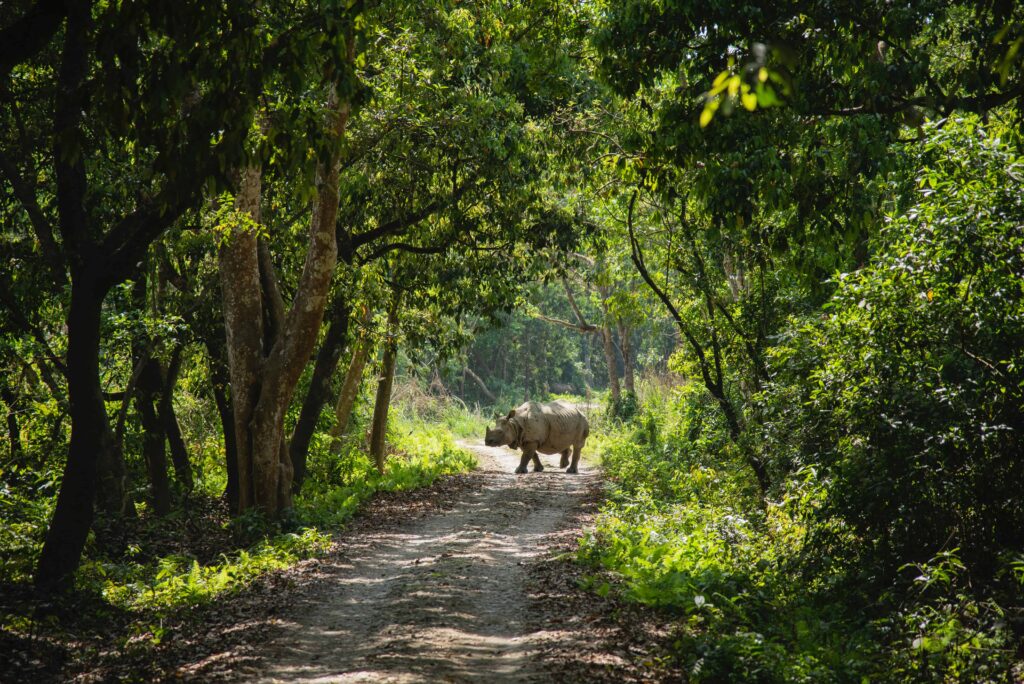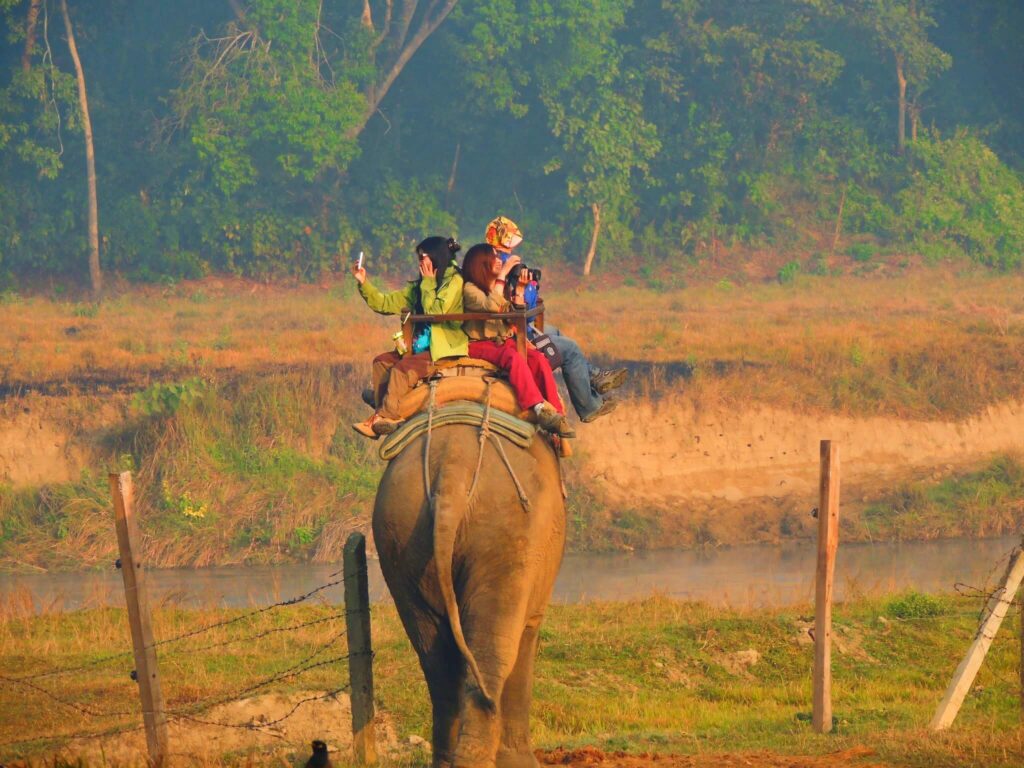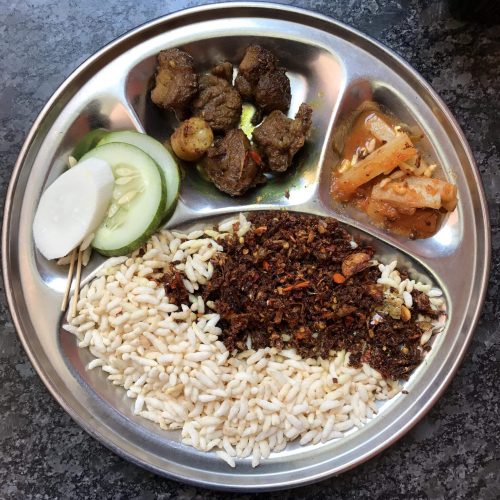Are you seeking a unique Nepalese adventure beyond the trails of the Himalayas? Chitwan, a UNESCO World Heritage Site, offers an intimate encounter with some of the world’s most rare and threatened species.
Situated in south-central Nepal, Chitwan is a top tourist destination and a significant industrial hub, connecting various regions of Nepal and even the border of India. Beyond its rich biodiversity, Chitwan is a cultural hotspot, home to the indigenous Tharu people. Travelers have the unique opportunity to immerse themselves in the Tharu culture, gaining insights into their traditions and way of life. Chitwan presents an unmissable blend of nature, wildlife, and culture for travelers looking beyond the Himalayan treks.
Chitwan is right up there on the list of places with it all. But what are the best things to do in Chitwan? Let’s find out!
7 Best Things to Do in Chitwan
1. Jungle Safari
Whether on foot, jeep, or atop an elephant, Chitwan National Park offers a captivating jungle safari experience, immersing visitors in its rich biodiversity. The most traditional way to explore is on elephant back, providing a unique vantage point as you pass by one-horned rhinos and densely forested areas. Jeep safaris are available for those favoring mechanized transport, with durations ranging from two hours to a full day.
Opting for the 4-hour ride is recommended to delve deeper into the park, increasing the chances of wildlife sightings. However, remaining inside the Jeep is crucial, as the animals are wild and can pose threats.
Walking safaris is one of the best things to do in Chitwan for a more intimate connection with nature. They offer a chance to stray from the main paths, enabling sightings of animals that might be missed on more conventional tours. Visitors are always accompanied by at least two guides and are given safety instructions, especially concerning encounters with the park’s aggressive mammals.
Regardless of the mode of exploration chosen, Chitwan promises an unforgettable experience rich in fauna and flora.
2. Elephant Bathing
Elephant bathing in Chitwan National Park and Sauraha has become a major attraction, with many competing to capture the perfect photograph of these bathing giants. The sight of elephants and humans bonding during these baths provides delightful entertainment for both participants and onlookers.
For those interested, tickets to participate in elephant baths by the Rapti River are available at numerous guest houses and travel agencies, typically priced between 200 to 500 rupees. Alternatively, for a more affordable experience, tourists can head to the river during the evening.
Here, Mahouts, or elephant riders, bathe their elephants after a day’s work, showcasing their bond and accepting tips. Visitors can relish the peaceful ambiance and the captivating sight of elephants enjoying their river bath as the sun sets. Get hands-on and join these gentle giants for a splash in the river. It’s fun, it’s exciting, and it’s memorable!
3. Boating/Canoeing
Canoeing in the Rapti and Narayani rivers is a highlight for tourists visiting the Chitwan National Park. These journeys offer a serene experience, especially during the early mornings, allowing visitors to observe myriad wildlife, including the rare Marsha Mugger and Gharial crocodiles, in their natural habitat.
The riverbanks teem with crocodiles sunbathing, while the waters and surrounding wetlands are abuzz with unique bird species and reptiles. Travelers can opt for canoe tours ranging from 1 to 3 hours, with the added opportunity to take short jungle walks and closely observe the environment. A local guide ensures a safe and enlightening journey through these pristine waters.
Floating down the river not only provides a chance to spot the fish-eating gharial crocodile and the marsh mugger but also invites travelers to immerse themselves in the tranquility of nature.
The journey can extend to Jagatpur, a noted tourist spot in Chitwan, located 18 km downstream from Sauraha. This immersive experience captures the park’s essence, making it a must-try for every nature enthusiast.
4. Tharu Culture Observation
The Tharu people, indigenous to the Terai region of Nepal, play a significant role in the cultural tapestry around Chitwan National Park. Visitors to the area can immerse themselves in the Tharu way of life by exploring the Chitwan Tharu Village.
This vibrant community showcases their rich customs, from language and festivals to marriage ceremonies. Nightly cultural programs offer glimpses of traditional Tharu dances, accompanied by the rhythmic beats of the Madal drum.
Two venues in Sauraha host these hour-long performances, starting at 6:30 pm and 7 pm, respectively, with an affordable entry fee of 200 NPR. Given the popularity, attendees should arrive at least 15 minutes early.
Venturing into the Tharu village reveals a mosaic of mud and clay houses, reflecting the community’s long-standing bond with the neighboring jungles. This proximity to nature is evident in their colorful traditions and customs, which have flourished for decades.
A guided tour of the village provides insights into the nuances of their daily lives, including their unique homes, culinary preferences, and attire. This cultural immersion is a poignant highlight for anyone visiting Chitwan National Park. Dive deep into the rich culture and traditions of the Tharu people. Their dances, songs, and stories are a treat for the soul.
5. Elephant Breeding & Training Center Visit
Get a behind-the-scenes look at how these magnificent creatures are cared for and trained. The Elephant Breeding & Training Center, located on the outskirts of Chitwan National Park, stands as a testament to preserving the majestic Asiatic elephant.
Just a short 3 km drive from the park, established in 1985, the center focuses on raising domesticated elephants and plays a pivotal role in protecting the region’s endangered pachyderms. Visitors can witness the daily routines of these gentle giants, from their meal preparations to consumption, while gaining insights into their behaviors.
The center boasts a unique opportunity to see baby elephants and houses a museum that provides valuable information about the species. Though the center uses chains, fences, and manual labor, they emphasize these measures as precautions for the animals’ safety.
For a nominal fee of 100 NPR, which is directed back to the elephants’ welfare, tourists can experience this conservation effort firsthand. As one of only two such centers globally, the Elephant Breeding Center in Chitwan National Park offers a profound glimpse into the world of these magnificent creatures and the endeavors to bolster their population.
6. Ox Cart or Pony Ride
Experience Chitwan the traditional way, riding through villages and farmlands. The Tharu village in Sauraha, Chitwan, offers unique experiences to visitors with its traditional Ox cart and Pony rides. These environment-friendly modes of transport are an excellent way to delve into the heart of the Tharu community.
A leisurely journey on this cart takes travelers through indigenous villages, leading to key attractions like the elephant stable and a museum dedicated to Tharu culture. On the other hand, a Pony Ride offers a more intimate glimpse into the daily life and history of the Tharu people.
Both experiences provide insight into the Tharu’s unique way of life and deep-rooted connection to the land. Whether on an Ox cart or a Pony, visitors are guaranteed an unforgettable journey through the vibrant Tharu community in Chitwan.
7. 20 Thousand Lake Tour
A birdwatcher’s paradise, this place teems with avian life and offers stunning views. 20 Thousand Lake, locally known as “Bish Hajari Tal,” is a renowned bird-watching haven located in the southern corner of Bharatpur, just 5 km from the city center of Chaubishkothi.
Nestled within the buffer zone of Chitwan National Park, this picturesque lake draws its name from its expansive series of small and large water bodies, resembling a count of 20,000 when viewed aerially. The area, brimming with biodiversity, serves as a winter refuge for migratory birds fleeing the cold of the Northern Pole.
The region is home to many crocodiles and occasional sightings of rhinos, making it a must-visit for wildlife enthusiasts. Visitors can access the lake by walking, cycling, or jeep from Bharatpur or Sauraha, with Chitwan National Park entry fees applicable.
While traversing the Inner Terai region of central Nepal en route to Bish Hajari Tal, travelers are treated to lush forested landscapes teeming with rare flora and fauna. Its proximity to Bharatpur offers convenient access, and the serene environment of the lake, coupled with the rich biodiversity, makes it one of Chitwan’s top attractions.
Whether you’re a birder, a reptile lover, or a nature fan, Bish Hajari Tal promises an immersive experience in the heart of Nepal’s wilderness.

Best Time to Visit Chitwan
For those looking to explore Chitwan at its finest, the months between October and March are ideal. The weather is pleasantly cool, and the skies are clear.
Also, the best time to see animals on a Chitwan National Park safari would be from January to March. But remember, beauty doesn’t wait for anyone; Chitwan is worth a visit any time of the year!
How to Get to Chitwan?
Sometimes, a journey is as exciting as the destination. And getting to Chitwan is no exception. Let’s explore the options:
1. By Flight
The quickest way to reach Chitwan is by air. Several daily flights connect Kathmandu to Bharatpur, the closest airport to Chitwan. From there, it’s just a short drive to the action’s heart.
2. By Tourist Bus
Travel in style and comfort with the many tourist buses between Kathmandu and Chitwan, as well as from other major cities. With scenic views along the way, it’s a journey you will remember.
3. By Public Transportation
Local buses and micros offer a unique and authentic experience for adventurous souls. They run frequently and are a great way to immerse oneself in the local culture.
3. By Private Car or Taxi
For those seeking a more personalized and comfortable experience, hiring a private car or taxi is the way to go. It offers flexibility and convenience.
Chitwan Altitude and Weather
Chitwan is situated at a relatively low altitude, approximately 415 meters above sea level. This low elevation contributes to its tropical climate, characterized by hot summers and mild winters. Chitwan has a tropical monsoon climate. Expect warm temperatures throughout the year, with a noticeable spike during summer. The highest recorded temperature in Chitwan is 37.9°C, and the lowest is 6.70°C.
Monsoon rains grace Chitwan between June and September, bringing lush greenery to life. In terms of weather, the climate of the Chitwan district is subtropical. The summer monsoon starts around mid-May and ends in late September, during which 90% of the yearly rain falls.
What Is Chitwan Famous for?
Chitwan is famous for Chitwan National Park, home to a wide variety of wildlife, including tigers, rhinos, elephants, crocodiles, and deer.
Chitwan is also known for its Tharu culture, a unique blend of indigenous and Hindu traditions.
Besides, Chitwan has gained widespread credit for its delicious Taas (Nepali: तास), a spicy fried goat meat delicacy accompanied by bhuja or cheura, and you can savor this culinary delight in numerous dining establishments across the region.
Chitwan National Park
An absolute must-visit! Chitwan National Park, established in 1973 as Royal Chitwan National Park, is the first national park of Nepal. Chitwan National Park, the district’s crowning jewel, boasts dense forests and a plethora of wildlife, including one-horned rhinos, Royal Bengal tigers, wild elephants, and sloth bears. A safari through these forests can be a once-in-a-lifetime experience, whether an enthralling elephant ride or a serene coracle trip down the river, where crocodiles can be spotted sunbathing.
Key features of Chitwan National Park includes:
- Biodiversity: The park is home to a diverse range of flora and fauna. It houses various species of mammals, birds, reptiles, and amphibians. Some of the notable wildlife species found in the park include the Bengal tiger, Indian rhinoceros, Asian elephant, sloth bear, and several species of deer.
- Rhino Conservation: Chitwan National Park is particularly famous for its successful conservation efforts related to the Indian one-horned rhinoceros. The park has played a crucial role in reviving the population of these endangered rhinos.
- Bird Watching: The park is a paradise for bird enthusiasts, as it boasts over 540 species of birds. Visitors can enjoy bird watching in the park, spotting various migratory and resident birds.
- Jungle Safari: One of the popular activities in Chitwan National Park is the jungle safari. Visitors can explore the park’s diverse ecosystems, including grasslands, riverine forests, and wetlands, on elephant-back, in jeeps, or on foot.
- Cultural Experiences: In addition to its natural beauty, the park offers cultural experiences with the local Tharu community. Visitors can engage in traditional Tharu dance, visit Tharu villages, and learn about the indigenous culture of the region.
- River Adventures: The Rapti River flows through the park, and visitors can enjoy activities like canoeing and river safaris. These activities provide an opportunity to observe aquatic wildlife and birds.

Distance of Chitwan District
Chitwan is strategically located in southwestern Nepal, an accessible destination for domestic and international travelers. The distance of Chitwan from major cities of Nepal is listed below:
Chitwan to Kathmandu: Approximately 180 kilometers. The distance is typically covered via the Prithvi Highway and East-West Highway.
Chitwan to Pokhara: Roughly 170 kilometers. This distance can be covered via the Prithvi Highway.
Chitwan to Hetauda: The distance is approximately 80 kilometers by road. The journey is typically covered via the Narayangadh-Muglin Road and then connects to the Tribhuvan Highway, which leads directly to Hetauda.
Chitwan to Butwal: Around 175 kilometers, mainly covered via the East-West Highway.
Chitwan – Nepalgunj: Approximately 410 kilometers. This journey usually involves traveling via the East-West Highway.
Chitwan to Dhangadi: About 540 kilometers, primarily covered via the East-West Highway.
Chitwan to Biratnagar: Approximately 400 kilometers can be covered via the East-West Highway.
Top Religious Sites for Visit While in Chitwan
Spirituality runs deep in Chitwan, and there’s no better way to experience it than by visiting its religious sites. If you’re interested in religion, Chitwan has many interesting religious places to visit, including:
1. Devghat Dham
Devghat Dham, located at the confluence of the Trishuli and Kaligandaki Rivers in Chitwan, is one of Nepal’s most spiritually significant religious sites.
Renowned for its serene environment, the area boasts a rich tapestry of history, tradition, and religious values. It is just 20 kilometers from Sauraha. Its unique geography and climate offer natural beauty. Numerous temples and caves dot the landscape, dedicated to various Hindu deities, with the notable inclusion of Goddess Sita’s cave. Many believe those who pass away here are directly ascended to heaven, a testament to its profound spiritual importance.
The annual Makar Sankranti Mela at Devghat is a major religious gathering, drawing devotees from across the country. The origin date of this festival is shrouded in mystery. During this event, Hindu pilgrims partake in ritualistic baths at the Krishna Gandaki River, renowned for its rare ‘Saligram Sheela’ (holy stone). Hindus worship this stone as a representation of Lord Vishnu. For both travelers and spiritual seekers, Devghat provides a blend of cultural richness and tranquil beauty.
2. Bikram Baba Temple
Bikram Baba Temple, located south of Jagatpur across the Rapti River, holds significant religious value, especially among the indigenous Tharu community.
Named after a Hindu god symbolizing a “brave guardian,” the temple is under a tree where a local discovered a stone believed to be in the shape of Bikram Baba around a decade ago.
Historically, the Tharu, Kumals, and Darais communities visited this sacred site, praying for blessings, particularly for children. The temple’s popularity has surged, attracting devotees from various ethnicities. Many believe that sincere worship here ensures the fulfillment of their wishes, often releasing pigeons and making sacrifices to express their devotion.
3. Maula Kalika Mandir
Maula Kalika temple, nestled atop a hill in Gaindakot, is a revered Hindu shrine dedicated to Goddess Kalika.
Positioned 561 meters above sea level, it overlooks the Narayani River. The temple is renowned for its spiritual significance, with devotees believing that the goddess grants wishes to those with pure devotion. Recent infrastructure developments since 2052 BS, including the temple’s pagoda-style construction, have boosted its popularity. Visitors are treated to panoramic views, including sights of the snow-capped mountains, Devghat, Chitwan National Park, and Sauraha.
The journey to the temple is an experience, with pathways adorned by slate, various smaller temples, and a conserved peace forest park. Devotees can also pay respects to Siddi Binayak Ganesh, Shree Krishna, and Deurali Devi along the route. The blend of spiritual reverence and the area’s natural beauty makes it a prime spot for domestic tourism.
4. Valmiki Ashram/Balmiki Dham
Valmiki Ashram, or Balmiki Dham, is a significant Hindu temple in Chitwan National Park in Nepal’s Chitwan district. The temple is near the Triveni Dham, the confluence of the Tamasa, Sona, and Sapta Gandaki rivers.
It is dedicated to deities Rama, Sita, and Valmiki and is renowned for celebrating the Rama Navami festival. Hindu lore suggests that Rishi Valmiki resided here and penned the epic Ramayana. Sita, Lord Rama’s consort, took refuge here during her pregnancy, and it was here that her sons Lava and Kusha were born.
The temple’s setting is amidst a well-preserved jungle, adding to its serene ambiance. Nearby, on the banks of the Triveni, lies another ashram of Valmiki Muni, highlighting the area’s religious significance. Access to this sacred site involves crossing the Triveni River or using the Gandaki barrage route near the Indian border.
The once-mighty Tamasa river, mentioned in Valmiki’s Ramayana, now flows as a smaller stream, sometimes referred to as Purnabhadra or Tamra Bhadra.
How Long Should I Stay in Chitwan?
The ideal duration of your stay in Chitwan depends on your interests and the activities you wish to pursue.
- Three to four days are ideal for soaking in all that Chitwan offers.
- However, for those on a tight schedule, a two-day visit can cover the major attractions.
Accommodation Options in Chitwan
From luxury resorts to cozy homestays, Chitwan offers many accommodations to suit every budget. And for those wondering about the best hotel in Chitwan or looking for Chitwan tour packages, numerous options cater to varied needs. When finding the perfect place to stay in Chitwan, you’ll discover various accommodation options to suit your preferences. However, for an exceptional experience, we highly recommend checking out Holiday Pasal as your top choice for accommodation.
Holiday Pasal offers a range of exquisite hotels and lodges in Chitwan that cater to diverse budgets and preferences. Whether you’re seeking a luxurious resort to indulge in the natural beauty of Chitwan or a cozy guesthouse for a more intimate experience, Holiday Pasal has you covered.
To explore the available accommodation options in Chitwan through Holiday Pasal. Please visit the best hotels in Chitwan.
What To Pack To Visit Chitwan?
Here is a list of essential items to pack for your trip to Chitwan:
- Sunscreen: The sun can be extreme in Chitwan, so it’s important to pack sunscreen with an SPF of 30 or higher.
- Hat: A hat will help to protect you from the sun and the rain.
- Sunglasses: Sunglasses protect your eyes from the sun and dust.
- Long pants and sleeves: It’s essential to cover your arms and legs in the jungle to protect yourself from insects and other wildlife.
- Mosquito repellent: Mosquito repellent is essential for preventing mosquito bites, which can transmit malaria and other diseases.
- Water bottle: It’s important to stay hydrated, especially when doing activities in the heat.
- Camera: Chitwan is beautiful, so you’ll want to bring your camera to capture all the fantastic memories.
- Binoculars: Binoculars are a great way to spot wildlife from a distance.
- Comfortable shoes: You’ll be doing a lot of walking in Chitwan, so it’s crucial to pack comfortable shoes.
Final Thought
Chitwan is more than just a destination; it’s an experience. From its rich biodiversity to its vibrant culture, it promises memories that will last a lifetime. Chitwan is a destination that captivates the hearts of nature enthusiasts, wildlife lovers, and culture seekers alike. With its breathtaking landscapes and diverse activities, it promises an unforgettable journey. So, pack your bags, embrace the wilderness, and explore all mentioned best things do in Chitwan , Nepal.






